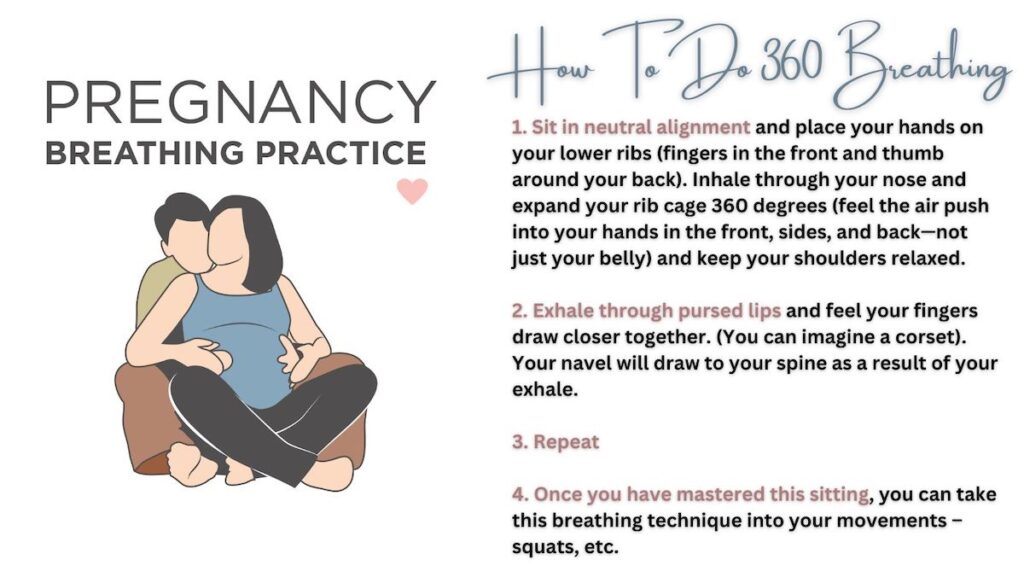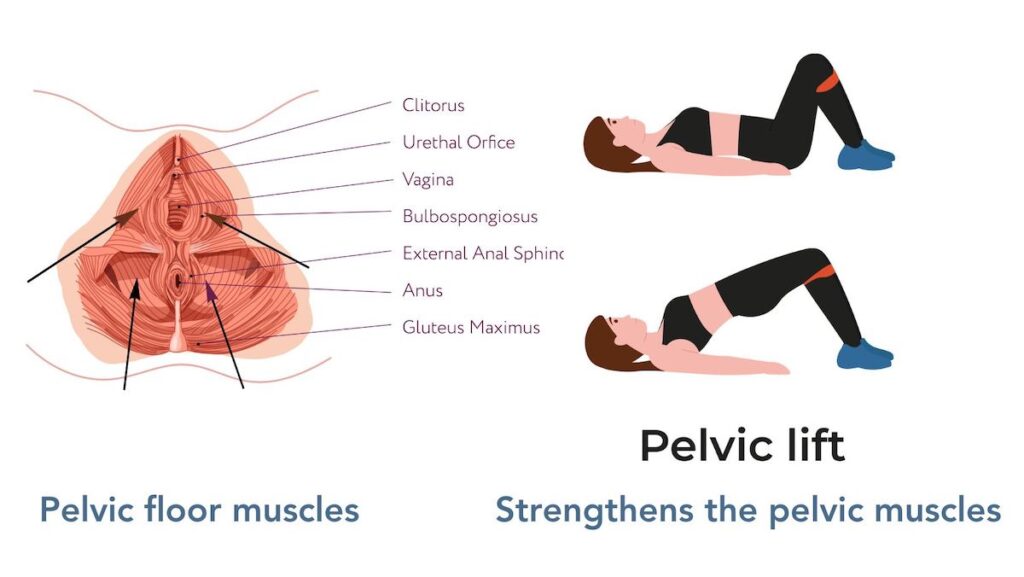360 breathing during pregnancy is an essential technique that can benefit expectant mothers. This holistic approach to proper breathing helps maintain core integrity and serves as a natural method for stress reduction and pain relief. This comprehensive blog post will delve into the importance of 360-degree breathing and how it can positively impact your pregnancy journey.
In this post we will explore how to practice 360-degree breathing effectively. You’ll learn how to engage your deep core during diaphragmatic breathing and support proper pelvic floor function.
In addition to these invaluable insights on 360-breathing during pregnancy, we will discuss focused-breathing exercises as pain relief during labor while supporting mental processes and also releasing endorphins for improved overall well-being. Lastly, we will emphasize the importance of consulting with healthcare providers before starting any new exercise regimen or breathing routine while listening closely to your body’s needs throughout this transformative time.
Table of Contents:
- The Importance of 360-Degree Breathing During Pregnancy
- Regulating Intra-Abdominal Pressure
- Improving Lung Capacity
- How to Practice 360-Degree Breathing Effectively
- Benefits of Diaphragmatic Breathing Postpartum
- Focused-Breathing Exercises for Pain Relief During Labor
- Reduce Stress and Anxiety with 360-Degree Breathing
- Safety Tips for 360-Degree Breathing During Pregnancy
- FAQs in Relation to 360 Breathing During Pregnancy
- Conclusion
The Importance of 360-Degree Breathing During Pregnancy
Proper breathing is key during pregnancy, and 360-degree breathing is the most effective pre- and postpartum breathing technique.
360 breathing helps regulate intra-abdominal pressure, improves lung capacity, calms the nervous system, promotes ideal oxygenation of blood for healthy baby growth and assists in lymphatic drainage to remove toxins from the body.
360-degree breathing is a deep breathing method that uses your breath to expand your rib cage and abdomen, In properly executed 36o breathing, your diaphragm contracts downward, generating intra-abdominal pressure that causes the pelvic floor and abdominal muscles to expand.
Regulating Intra-Abdominal Pressure
360-degree breathing can prevent excessive strain on your abdominal muscles and pelvic floor, reducing the risk of developing issues like diastasis recti or pelvic organ prolapse.
Improving Lung Capacity
Chest breathing exercises expand your lungs fully and ensure optimal oxygen supply for your growing baby. Deep breathing while raising the arms strengthens the diaphragm and widens the lungs. More oxygen is taken in due to the lungs’ capacity growing.
Calming the Nervous System – 360 Breathing Benefits
- Breath awareness: Mindful 360-degree breathing encourages relaxation.
- Fight-or-flight response: Deep diaphragmatic breaths activate our parasympathetic nervous system, counteracting stress-induced fight-or-flight responses.
- Mental clarity: 360-degree breathing can help improve mental clarity and focus.
Research has shown that proper breathing techniques during pregnancy have numerous benefits for both mom and baby.
How to Practice 360-Degree Breathing Effectively
Posture is everything
Sit straight with your ribs over your pelvis, neck long, and shoulders relaxed to maximize airflow and muscle engagement.
Breathe out on effort
Many people do not realize it, but we tend to hold our breath when exerting effort during even mild workouts. Exhale as you engage in physical activity to activate core muscles and support your pelvic floor.
Proper breathing gives your body more control and keeps you relaxed and attentive during your workout, allowing you to use all of your muscles more effectively.
With time correct breathing techniques will:
- Minimize the air you need to breathe in and out when exercising to reduce the carbon dioxide your muscles produce
- Increase cardiac health and blood flow
- Maximize your fitness and exercise levels
Try box breathing
- Inhale for four seconds.
- Hold for four seconds.
- Exhale for four seconds.
- Pause for four seconds before inhaling again.
This promotes rib cage movement, improves lung capacity, and encourages diaphragmatic breathing over shallow upper-chest-only breaths. Breathwork can help you navigate occasional stress and anxiety attacks, shortness of breath during pregnancy, connecting to your pelvic floor and preparing for labor contractions.
Note: Consult a healthcare provider before starting any new exercise routine or breathing exercises and adjust intensity based on individual needs.
Practicing 360-degree breathing during pregnancy can improve lung capacity, calm your nervous system and promote healthy baby growth.
Benefits of Diaphragmatic Breathing Postpartum
Deep breathing during pregnancy and postpartum has long-term benefits. After your baby is born, you can continue 360 breathing postpartum to restore inner unit strength and promote holistic healing of your core and pelvic floor.
Restoring Holistic Healing Inner Unit Strength
Research has shown that proper breathing techniques can improve core stability, increase core strength, support the pelvic floor, and reduce lower back pain post-pregnancy.
Engaging Entire Deep Cores for Pelvic Floor Function
- Pelvic floor muscle activation: Properly executed diaphragmatic breathing activates the pelvic floor muscles, transverse abdominis, and multifidus for optimal pelvic floor function. The pelvic floor consists of 14 muscles that form a sling the bottom of the core and support the pelvic organs, stabilize the pelvis, control continence, aid in sexual response and assist in guiding the baby out during labor.
- Faster recovery from childbirth: A strong pelvic floor supports internal organs and prevents issues like urinary incontinence or prolapse.
- Better posture: 360 breathing strengthens your deep core and encourages proper spine alignment, reducing discomforts often experienced during pregnancy and postpartum periods.
Diaphragmatic breathing can be a beneficial addition to your daily routine but check with your healthcare provider before starting any new breathing techniques. Before beginning any new exercise regimen, consult a healthcare provider and observe your body’s signals.
Focused-Breathing Exercises for Pain Relief During Labor
Proper breathing techniques during pregnancy can help women cope better with labor pain.
Stimulating Mental Processes Through Breathwork
Studies have shown that focused-breathing exercises can shift attention away from pain sensations and tap into a sense of calmness.
Releasing Endorphins for Pain Relief
360-degree breathing stimulates the release of endorphins, acting as analgesics to reduce pain perception and provide relief without side effects.
Improving Overall Wellbeing During Labor
- Mental benefits: Focused breathing helps reduce anxiety levels by promoting relaxation.
- Emotional benefits: Breathing exercises allow mothers-to-be to support their emotions.
- Physical benefits: Proper oxygenation through deep breaths ensure both mom and baby receive adequate oxygen for healthy growth and development.
Incorporating focused-breathing exercises into your prenatal routine can help you better manage pain during labor and ensure the best possible conditions for welcoming your newborn. Before engaging in any physical activity, get approval from your healthcare provider.
Reduce Stress and Anxiety with 360-Degree Breathing
Manage stress and anxiety during pregnancy with 360-degree breathing, a grounding breathwork exercise that connects mind and body.
Connect with Your Body through Breathwork
Proper breathing techniques like chest or diaphragmatic breathing promote relaxation and reduce stress.
Promote Positivity for You and Your Baby
Maintain a positive outlook during pregnancy with 360-degree breathing, which releases negative thoughts and feelings.
- Breath Deeply: Inhale slowly through your nose, allowing air into your lower abdomen before filling the rest of your lungs.
- Focused Exhales: Exhale gently through pursed lips, engaging core muscles effectively without causing undue strain on abdominal tissues.
- Square Breathing: Practice the square breathing technique to regulate your nervous system and balance body and mind.
Incorporate 360-degree breathing into your daily routine during pregnancy to manage stress levels and promote overall well-being.
Safety Tips for 360-Degree Breathing During Pregnancy
Before beginning any new exercise routine, consult your healthcare provider to ensure it is safe for you and your baby.
Pay attention to your body and modify the intensity of exercises according to what you need.
Consult with Your Healthcare Provider
It’s important to prioritize safety during pregnancy, so talk to your healthcare provider before incorporating 360-degree breathing into your routine. They can offer personalized advice and ensure this practice aligns with your unique health situation.
Listen to Your Body
Pay attention to how you feel physically and emotionally when incorporating diaphragmatic breathing into your workouts. Take breaks, avoid overexertion, and incorporate modifications as needed.
- Take breaks: Allow ample time for rest periods during workouts or focused breathing sessions.
- Avoid overexertion: Keep the intensity level moderate to avoid straining muscles already working overtime due to pregnancy-related changes.
- Incorporate modifications: Adjust positions based on trimester progression to ensure comfort.
Taking these safety precautions ensures that your 360-degree breathing practice is beneficial and safe during pregnancy.
FAQs in Relation to 360 Breathing During Pregnancy
What is 360-degree breathing during pregnancy?
360-degree breathing, diaphragmatic or deep belly breathing, helps pregnant women maintain core integrity, improve lung capacity and regulate intra-abdominal pressure.
What are the benefits of 360-breathing?
- Regulates intra-abdominal pressure
- Improves lung capacity
- Calms the nervous system
- Promotes proper posture
- Supports pelvic floor function
- Reduces stress and anxiety
- Supports digestion
- Reduces pregnancy-related aches and pains
- Aids in a faster postpartum recovery
Is breathwork safe for pregnancy?
Breathwork techniques like 360-degree breathing are generally safe for most pregnant women. Still, it’s crucial to consult your healthcare provider before starting any new exercise routine and always listen to your body while practicing.
How do you practice 360-breathing?
To practice 360-breathing effectively: sit or stand comfortably with proper posture; inhale deeply through your nose, expanding your abdomen fully; exhale slowly through pursed lips engaging your core muscles. Try box breathing or focused-breathing exercises for additional benefits.
Conclusion
Practicing 360-degree breathing during pregnancy benefits both mother and baby by regulating intra-abdominal pressure, improving lung capacity, calming the nervous system, maintaining core integrity, providing pain relief during labor, and reducing stress and anxiety.
Breathing techniques, such as 360 breathing or box breathing, can improve overall well-being during pregnancy and postpartum. Engaging the deep core supports proper pelvic floor function, promotes a holistic approach to integrated deep core strength and leads to a healthier pregnancy experience. Want to get in touch about pre and post-natal classes?
7-Day Free Trial Classes
Follow this link to start today: GET YOUR 7-DAY FREE TRIAL NOW
Or contact us here.


